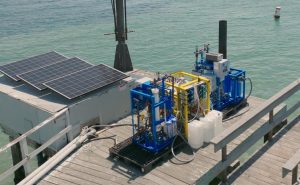Workshop clarifies path for evaluating mCDR environmental effects in California

A two-day workshop at SCCWRP that explored the implications of piloting marine carbon dioxide removal (mCDR) technologies in California coastal waters has helped bring clarity to the technical and regulatory challenges that remain for these prototype approaches to be evaluated at larger scales.
The workshop, held October 7-8, 2024, brought together multiple State agencies, scientific experts, industry and environmental advocacy organizations to discuss the potential environmental consequences of mCDR and how these effects might be monitored or modeled.
mCDR technologies involve either modifying the ocean’s chemistry to increase seawater’s ability to take up carbon dioxide from the atmosphere (such as by altering ocean alkalinity), or increasing the photosynthetic power of the upper ocean to move and/or sequester carbon dioxide in deeper waters (a research area that includes kelp farming).
Private companies, governmental agencies and philanthropic organizations have invested millions of dollars exploring how to use ocean-based mCDR processes to remove carbon dioxide from the atmosphere and store it for extended periods in the ocean.
To date, less effort has been expended evaluating environmental effects because existing mCDR technologies are mostly operating at smaller pilot scales.
Although U.S. coastal waters have been a locus for mCDR technology incubation, many coastal states, including California, lack the scientific information that would enable coastal managers and communities to evaluate the potential, unintended ecosystem effects of larger-scale mCDR projects in the future – and ultimately decide whether to greenlight these projects.
Researchers hypothesize that if mCDR could be scaled in coastal marine environments, these technologies have the potential to help draw down carbon dioxide from the atmosphere that is driving global climate change. In addition, some technologies may also be able to offset local ocean acidification, a marine phenomenon driven primarily by atmospheric carbon dioxide emissions that is making the ocean a less habitable place for vulnerable marine life.
The international Intergovernmental Panel on Climate Change has found that while the rate at which carbon dioxide is being released into the atmosphere will need to be drastically reduced to limit the worst effects of climate change, large-scale approaches like mCDR have the potential to help draw down existing carbon dioxide in the atmosphere and counterbalance sectors that will be difficult to decarbonize.
In California, one impediment to implementing mCDR is figuring out how to guard against mCDR’s potential unintended ecological effects. Before deciding whether to approve future, larger-scale mCDR pilot projects, coastal managers and communities will need to understand the consequences of introducing new materials into marine ecosystems, the effects of altering seawater conditions on nutrient and carbon cycles, the efficacy of carbon removal, sequester and storage, and the cumulative impacts of these changes on marine life.
During the two-day mCDR workshop, researchers worked alongside regulatory and resource agencies to begin conceptualizing scientific assessment frameworks that could guide mCDR practitioners in evaluating the ecosystem effects of their projects.
Workshop participants agreed that while existing, small-scale pilot tests of mCDR technologies are unlikely to trigger consequential ecosystem effects, iteratively scaling up demonstration projects would be an important next step for evaluating potential ecosystem effects.
The workshop’s co-hosts – California Ocean Science Trust, the U.S. Ocean Carbon and Biogeochemistry program’s California Current mCDR Node, and SCCWRP – will summarize the workshop’s findings and recommended next steps in a series of reports, including a workshop executive summary, scientific outcomes, and recommendations. The reports are expected to be published in mid-2025.
For more information, contact Dr. Christina Frieder.
More news related to: Climate Change, Ocean Acidification and Hypoxia, Top News